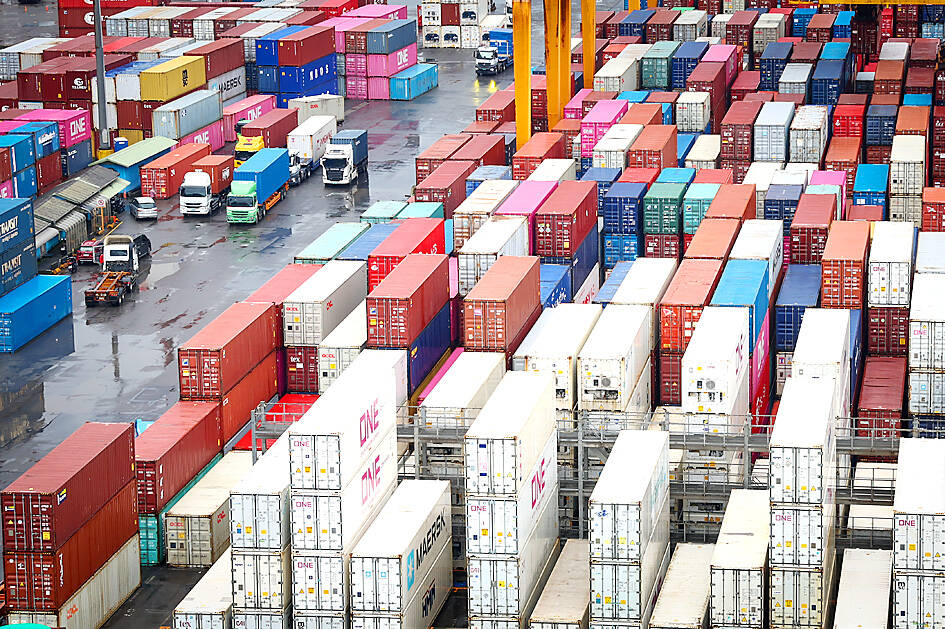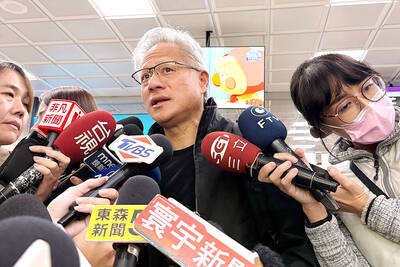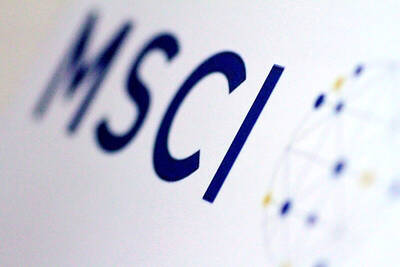The US overtaking China as Taiwan’s top export destination could boost industrial development and wage growth, given the US is a high-income economy, an economist said yesterday.
However, Taiwan still needs to diversify its export markets due to the unpredictability of US President Donald Trump’s administration, said Chiou Jiunn-rong (邱俊榮), an economics professor at National Central University.
Taiwan’s exports soared to a record US$51.74 billion last month, driven by strong demand for artificial intelligence (AI) products and continued orders, with information and communication technology (ICT) and audio/video products leading all sectors.

Photo: CNA
The US reclaimed its position as Taiwan’s top export market, accounting for 30 percent of total exports — surpassing the combined 27.2 percent share of China and Hong Kong.
Commenting on the structural shift in Taiwan’s exports, Chiou noted that Taiwan’s previous heavy dependence on China — once exceeding 40 percent of total exports — raised concerns about over-concentration in a single market and product.
However, global supply chain realignments and rising US-China tensions have led to a significant shift in Taiwan’s export structure.
Chiou explained that although Taiwan’s export focus has shifted from the Chinese market and ICT products to the US market and AI goods, it may seem like the same story is repeating, but with different implications.
First, Chiou noted that since the US is the world’s largest economy, a 30 percent export share to the country is not excessive.
Second, the US is not only the world’s most important market but also a high-income, advanced economy, he said. While both the US and China are major export markets for Taiwan, their implications differ greatly, he added.
Looking back, Chiou recalled that when Taiwan signed the Economic Cooperation Framework Agreement with China in 2010, there were concerns that closer ties would lower wages and increase unemployment. He cited concerns over the economic theory of "factor price equalization," which suggests free trade equalizes wages and rents between countries.
In contrast, Chiou said deepening trade ties with the US could drive industrial development and wage growth in Taiwan. Closer access to end markets would help shift Taiwanese industries toward higher value-added segments, he added.
However, Chiou warned that to mitigate risks from Trump’s erratic policies, Taiwan should pursue greater export market diversification.
Gordon Sun (孫明德), director of the Economic Forecasting Center at the Taiwan Institute of Economic Research, said AI servers sold mainly to the US helped push America past China as Taiwan’s largest export market.
However, Sun said this structural shift in exports is largely driven by a single product category, and whether the trend will continue remains uncertain.

PERSISTENT RUMORS: Nvidia’s CEO said the firm is not in talks to sell AI chips to China, but he would welcome a change in US policy barring the activity Nvidia Corp CEO Jensen Huang (黃仁勳) said his company is not in discussions to sell its Blackwell artificial intelligence (AI) chips to Chinese firms, waving off speculation it is trying to engineer a return to the world’s largest semiconductor market. Huang, who arrived in Taiwan yesterday ahead of meetings with longtime partner Taiwan Semiconductor Manufacturing Co (TSMC, 台積電), took the opportunity to clarify recent comments about the US-China AI race. The Nvidia head caused a stir in an interview this week with the Financial Times, in which he was quoted as saying “China will win” the AI race. Huang yesterday said

Nissan Motor Co has agreed to sell its global headquarters in Yokohama for ¥97 billion (US$630 million) to a group sponsored by Taiwanese autoparts maker Minth Group (敏實集團), as the struggling automaker seeks to shore up its financial position. The acquisition is led by a special purchase company managed by KJR Management Ltd, a Japanese real-estate unit of private equity giant KKR & Co, people familiar with the matter said. KJR said it would act as asset manager together with Mizuho Real Estate Management Co. Nissan is undergoing a broad cost-cutting campaign by eliminating jobs and shuttering plants as it grapples

The Chinese government has issued guidance requiring new data center projects that have received any state funds to only use domestically made artificial intelligence (AI) chips, two sources familiar with the matter told Reuters. In recent weeks, Chinese regulatory authorities have ordered such data centers that are less than 30 percent complete to remove all installed foreign chips, or cancel plans to purchase them, while projects in a more advanced stage would be decided on a case-by-case basis, the sources said. The move could represent one of China’s most aggressive steps yet to eliminate foreign technology from its critical infrastructure amid a

MORE WEIGHT: The national weighting was raised in one index while holding steady in two others, while several companies rose or fell in prominence MSCI Inc, a global index provider, has raised Taiwan’s weighting in one of its major indices and left the country’s weighting unchanged in two other indices after a regular index review. In a statement released on Thursday, MSCI said it has upgraded Taiwan’s weighting in the MSCI All-Country World Index by 0.02 percentage points to 2.25 percent, while maintaining the weighting in the MSCI Emerging Markets Index, the most closely watched by foreign institutional investors, at 20.46 percent. Additionally, the index provider has left Taiwan’s weighting in the MSCI All-Country Asia ex-Japan Index unchanged at 23.15 percent. The latest index adjustments are to